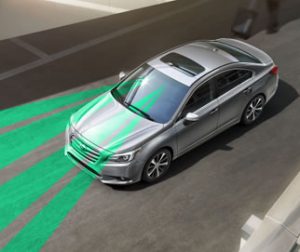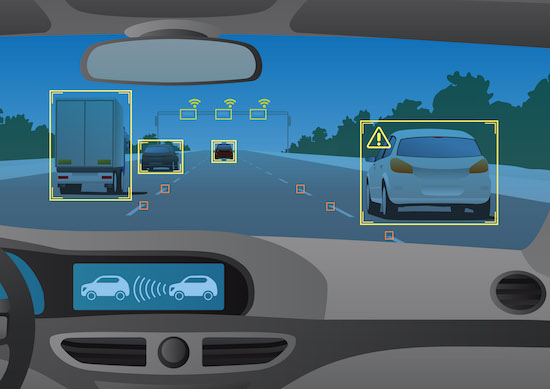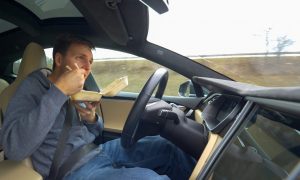Almost every new car comes standard with various driver “assistance” technology such as Brake Assist, Lane Keep Assist and Park Assist. New forms of “assistance” propagate with each new model year and sometimes sooner.
It raises questions about people’s competence to drive without such “assistance.”
Especially when such “assistance” becomes unavailable.
Which happens for the same basic reason that you lose the “assistance” of your eyesight when a gnat flies into your eyes. The driver “assistance” tech in all new cars relies on cameras, mounted around the perimeter of the car. What happens when they can no longer see? Because the camera cannot see through fog? Or because the lens is covered by a layer of ice? And the software/programming is stymied by unforeseen conditions?
You no longer have “assistance.”
This has happened to me numerous times, since I drive numerous new cars and often in fog or sleet and snow – as most of us have to do because those conditions obtain out in the real world.
As opposed to the showroom.
Dust and mud do the trick, too. Tall berms by the side of the road (especially in curves) also sometimes do the trick, fooling the camera into “seeing” an obstacle ahead that isn’t really there – or rather, isn’t in the travel path of the vehicle. But not having a mind, the “assistance” tech can’t tell the difference and so “assists” . . . by slamming on the brakes in the middle of the curve.
Or in the middle of the road, for no apparent reason at all.
Such things have happened to me a number of times, in a variety of different cars – so it is not a make/model specific problem. And it happened again, just yesterday, in the ’21 Subaru Crosstrek I am test driving at the moment.
It was very foggy out. I could still see – but the Subaru’s EyeSight system couldn’t. For a variety of reasons, a non-biological eye cannot (yet) see as well as a biological eye in good working order. And some of the non-biological eyes affixed to the exteriors of new cars cannot wipe away a crust of ice or splash of mud, causing them to not see very well, if it all.
And then the “assistance” no longer does.
As happened in the Subaru I was driving – because of the heavy fog. A warning chime sounded, an icon illuminated – to let me know I was no longer being “assisted.”
For those drivers accustomed to such “assistance,” this is arguably dangerous – analogous to an airplane that doesn’t expect the pilot to be able to fly it competently at all times and then sometimes stops flying it for him.
This is interesting given the “assistance” is marketed as a “safety” advance.
Perhaps even more dangerous than a false “assist” – as because of a berm in the curve that the tech confuses with something in the road – is the absence of “assistance,” when a “driver” (finger air quotes for the obvious reason) assumes it will be there to “assist” him . . . and “drives” accordingly. And is following too closely to stop safely when the car ahead brakes suddenly. Our “driver” was texting because he depended on “assistance” to notice the problem and apply the brakes on his behalf but the “assistance” is offline because of fog or some other reason.
The manufactured problem of encouraged inattentiveness. Which of course is what this “assistance” is really all about. The enabling of non-driving.
Who wants to pay attention to the road when an important text just arrived? Lane Keep Assist will “assist”!
And who wants to learn to parallel park when “assistance” will do that for them?
Which gets us to a more profound problem with all of this “assistance”:
Before there was “assistance” drivers had to learn to parallel park a car themselves, without any “assistance.” It was even one of the tests of competence necessary to display in order to qualify for a license to drive. Those who couldn’t do it were presumed – correctly – to be lacking the basic competence necessary to safely drive a car.
Even if not formally tested, the incompetent were self-selected out of the driver’s seat by their own incapacity, whether as regards parallel parking or other basic competencies, such as being able to keep the car they were driving in its lane, without “assistance.”
If not, nature took its course.
And fear kept incompetence somewhat in check. People drove within their limits and they paid more attention – because consequences.
Now the incompetent are encouraged to be dangerously fearless. To be oblivious to their own appalling incompetence as drivers. This is enabled and encouraged by the car industry, which has drunk deep of the “safety” Kool Aid, which addresses risk by discouraging competence. Why teach kids not to touch a hot stove? Instead, sell their parents a stove with some kind of barrier or cover and perhaps a sensor and buzzer that eructs when anyone gets near the thing!
It doesn’t matter that the adults know not to touch the stove – having learned what happens if they do – nor that the kids never will learn to be careful around the hot stove.
What matters is that everyone feels “safe.” Even if costs everyone their adulthood.
That seems to be the design ethos at work. Don’t encourage competence – crutch incompetence.
It’s not very “safe.” But it does seem to sell.
Like the “masks” and the shots. It’s all driven by the same disease. This bizarre obsession with “safety” – that puts everyone at even greater risk.
. . .
Got a question about cars, Libertarian politics – or anything else? Click on the “ask Eric” link and send ’em in!
If you like what you’ve found here please consider supporting EPautos.
We depend on you to keep the wheels turning!
Our donate button is here.
If you prefer not to use PayPal, our mailing address is:
EPautos
721 Hummingbird Lane SE
Copper Hill, VA 24079
PS: Get an EPautos magnet or sticker or coaster in return for a $20 or more one-time donation or a $10 or more monthly recurring donation. (Please be sure to tell us you want a magnet or sticker or coaster – and also, provide an address, so we know where to mail the thing!)
My eBook about car buying (new and used) is also available for your favorite price – free! Click here. If that fails, email me at [email protected] and I will send you a copy directly!














Eric – Agreed re Never-developed competence.
The same applies to math skills. Kids should never be allowed to use a calculator until they have memorized the multiplication tables. You should be able to wake your child at 3 in the morning and ask them what 6 times 7 is, and get the right answer (a pet peeve.)
All this crappy technology is anti-human. It creates a sense that the virtual world is somehow real. It all adds up to installing more and more control and that it is now up to us to surrender our lives to some arrogant control freaks who hate humanity.
The late great golden age science fiction writer Robert Heinlein wrote starting early then far later into his long career about self driving road vehicles in his near future set plots. Of course he wrote fiction not technical manuals so exact solutions to the manifold imbedded problems were not his purview, just intriguing readers with some fun stuff. More significantly he rarely displayed in his fiction explicit description of the true character of the personages & elements running the world which may have been because he eschewed such a malign view so he assumed for a given story’s sake their nature & intentions were on net benign. Though in 1961 in the novel Stranger in a Strange Land he indicated a bit ominously the authoritarian potential of a central government mandated highway system inter-acting with robotizable cars. Mobility is married to liberty in any truly legitimate polity no matter what is promised or even deliverable in the name of public safety. That the exalted public safety goods can not yet be delivered & may never be deliverable leaves our alleged betters–throwing about our money–markedly undeterred though!
Hi TailGunner,
Indeed! Liberty and mobility are facets of the same jewel and without either the other becomes a kind of nullity. Being able to go where you want to go, when you want to go and how is perhaps the essential liberty since if you can’t do those things, even property becomes an almost useless possession.
I considered purchasing a Crosstrek, but found the assist to be annoying, and the car is also slow. Apperently, the cameras are in the windshield so the windshield is around $1500 to replace and the cameras have to be recalibrated even if you dont use the system. Also, even though a 6spd manual is “standard” you have to special order it and wait months to receive it cause Subaru only sends cvts to the dealerships.
I got a 6 spd wrx instead. No driver assist. Its very annoying that they made them without ground clearence.
Hi Anon,
Yup; I’ve had several reports about the difficulty finding a manual-equipped Crosstrek. I’ve passed these along to Subaru. Hoping to hear something positive from them soon…
The slogan for the “brave new world” should be “We claim lives, to save lives.”
And as for those “safety” stoves, they actually DO exist. They’re called “induction cooktops”. Gee, can’t wait for those new “blade-less” laser hedgetrimmers! I mean, who cares if you accidentally burn your house down with them? At LEAST you didn’t maim yourself! lol
Hello, Eric. As the “Driver Assist” was not working for you, did that mean you had to listen to that annoying beep the entire drive? It is too bad you cannot simply figure out where the driver-assist sensors are, and stick some duct tape on them, and be done with the whole programme. Yuck, nothing like a nanny shilling in your ear while you are behind the wheel. No wonder so many drivers are pissed off. All those “dings”, bells, and such would drive any half-sane driver crazy. Just let me drive and enjoy my music, thank you! It is why-when the time comes-I will simply drop a new engine in my 2007 vehicle, as it does not have any of this “saaaafffeety” crap on it. I just rolled over to 221,000 miles, and hope I can get another 100,000 out of it.
Now in New York they want to pay more bureaucrats to concoct ratings of how likely vehicles are to run over pedestrians.
https://www.bloomberg.com/news/articles/2021-05-24/pedestrian-safety-ratings-target-suvs-and-pickups?srnd=premium
Hey Eric,
I know the point of your article was how all these driver assists can actually become a hindrance whether interfering with the driving experience by false alarms, glitches, contributing to the incompetence of the driver etc. etc. etc. But, what is the monetary cost of all this added safety BS? How many extra hundreds if not thousands of $$$ does it add to the price of a new car? How many hundreds of $$$ will it add to repair bills over the lifetime of the vehicle? I’ll go out on a limb here and say no back yard mechanic can easily fix any of these safety systems himself. Can you even buy a new vehicle without these safety systems? I honestly don’t know as it has been many years since I have been shopping for a new car. GM makes some inexpensive cars in China/India, and I’m betting those inexpensive cars do not have any added safety BS on them. This is definitely a problem of Uncle sticking his nose somewhere it does not belong. All the problems with new cars can be traced back to the heavy hand of Uncle and his safety fatwas, from the same styling seen on all new cars making them look basically the same (so they are safe when they flip over), to the standardization of 4 cylinder engines to squeak out a few more mpg to please Uncle, and the infatuation with driver assists to perpetuate the illusion of safety. The car companies rolled over and died just to please Uncle and meet his ridiculous decrees.
My 2 vehicles have minimal driver assists ABS and cruise control are about it, and I don’t even think cruise control qualifies. I do like ABS. It has helped me out a lot stopping on wet pavement during the frequent rain storms we get in Florida. However, my first car was a 1970 Nova with manual drum brakes on all 4 wheels. I learned how to drive on wet and icy pavement without any assists. You know, steer in the direction of the skid, gently pump the brakes to keep from hydroplaning. I know what to do. However, would a driver who has never driven a vehicle without ABS know what to do? Probably not. Being used to ABS, the driver would mash his brakes, find himself hydroplaning, and quickly lose control of his vehicle. ABS has eliminated a very important skill of driving, and made the roads more dangerous in certain situations.
Hi Rush2,
The answer is – a great deal. Not so much up front as new electronics are relatively cheap. But down the road, when those electronics fail and must be replaced by a $100/hour dealer technician. That’s the time bomb embedded in every new car. They work seamlessly. Until one day, they no longer do. And when they don’t, it’s not generally something most people can fix themselves. Even replacing a cracked windshield – something that used to cost $150 or so – now can easily cost three times that because of the embedded electronics.
While new cars have a number of admirable qualities – including unprecedented power – the inherent disposability makes me want no part as I am not interested in becoming enserfed to a car payment, never ending!
“Even replacing a cracked windshield – something that used to cost $150 or so – now can easily cost three times that because of the embedded electronics.”
Wait until windshields become windscreens, literally. Why use cheap, “dangerous” laminated glass, when we can have an LED screen(s) inside and an array of cameras to show the outside world? After all, “we have the technology”.
Kudos on this.
I have loathed the idea that my car would tell me how to drive. I am the human. I bought you. Shut up and do what I tell you.
But no, those in “charge” of rulemaking view us all as brainless boobs, who without the good will of govt, wouldn’t be able to wipe our own holes.
I will grant, this last year has shown this may be true. Pen all those people in their safety prisons and leave the rest of us alone.
As a motorcycle rider, all this stuff scares the hell out of me. My stepmother read that the lane assist computers sometimes don’t “see” motorcycles and will go ahead and instruct the meatsack in the driver’s seat (not actually a driver, per se) to switch lanes.
It was awhile back and may have been remedied by this time, but who knows? It’s bad enough to have to fear the brain dead moron paying more attention to his phone or his girlfriend than the road; now we have to worry about his brain dead car, too.
Ditto, Amy –
I ride also and he threat level has probably never been higher on account of the encouraged inattentiveness of so many “drivers” out there. I try to stay as far away from them as I can.
PS: Should be getting some press bikes soon!
There has been a steep increase in motorcycle fatalities in Australia. This may be one reason.
Hi to5,
It is getting worse here as well. I am not surprised that some equip their bikes with flashing headlights. Yup, really. And loud pipes make great sense, too.
Anything to penetrate the addled brains of these sail-fawn-tapping cagers.
It’s amazing in this “safety at all cost world”, that these unfinished, unproven and very glitchy technologies are put into vehicles. If the government was actually concerned about our safety, they wouldn’t allow it. Keep it on the test track Elon, he would be told.
But when you understand “the agenda” that our rulers have in store for us, its pretty clear. Our “safety” means absolutely nothing to them. The reality is that actual working driving technology isn’t anywhere in the near future, so this half baked crap is foisted on us.
They are tired of waiting, and frankly real working driver tech may never come. The tech world doesn’t seem to really care much about reliability and durability, both which are needed for driving cars. The computer world for example has had nearly thirty years to develop a truly working web browser (the ones we use are glitchy messes) and we still wait for that to happen. A car is a bit more complex than a web browser. So I don’t see it happening anytime soon with the way software is developed. It’s pie in the sky as much as creating a mainstream electric car, it just can’t happen the way they want it to.
I would never trust a car to drive itself. Not with it the way it is.
Exactly – *THEY* (TPTB) are not worried about safety at all – they just want YOU to be.
The assistant stance tends to kick out at the exact times when extra driving skill is required. But how can you have the skills to finesse your way out of a difficult situation, if your skills at regular driving are not yet developed because you never use them because you rely on the assist?
Yet again we are encouraged into a state of entirely avoidable, passive helplessness.
This is not necessarily a bad thing. In the long run, the world is ours, if we want it, because everyone else is a mollycoddle.
Hi Publius,
I didn’t get into in the article but stability control is another of a piece. People without the skills to drive a car fast drive above their skill level because the car gives them the false confidence to do so. But push it enough and even stability control won’t save your bacon and when the car goes sideways, if you don’t know how to recover, you’re in the soup.
“Safety” first!
I no longer own it, but had a 2008 MX5 with stability control, which made the car squirrely in curves, at well below the car’s limits.. As if it couldn’t decide what to do. I ended up “assisting” the car. Needless to say, the only time it was ever on after that was on ice or snow, since the feature also included traction control.
I would think that any of these “assist” functions would have a significant hitch when engaging/disengaging. A sudden small, or not so small change in the handling dynamics. I didn’t drive mine engaged after the first trial, except on snow, so I don’t recall.
Eric,
Don’t these “assists” use other tech, such as RADAR and LIDAR, in addition to the cameras?
Sometimes they do, but generally no, not for assists. LIDAR is too expensive, radar is too noisy. I work with this technology on a daily basis, as I work on making self driving tech that actually works.
Here are some things to keep in mind.
– The best automotive grade cameras are nowhere near as capable as your eye. However, you can put many of them on a car, not just two, in many locations, and you can use infrared and ultraviolet cameras as well, which see far more than a human can. IR is really good at night, UV gives you some more info about material properties that you normally wouldn’t see.
– Lidar is very precise at measuring distance to things, but not identifying what they are
– Radar gets you a list of the nearest blips, and their relative speeds, without necessarily knowing their locations.
For example with radar, you see one blip moving at relative speed near zero, that’s probably a car near you. Now, you’re going at 65mph and you’re approaching a blip at 65mph. Is it a wall? An overhead billboard? A stopped truck? No way to know without cross-referencing against lidar or radar.
Now, all these sensors feed into state of the art machine-learning based perception systems and fancy hand-crafted algorithms. If you take the best of these, feed all those inputs into it, you end up with a half blind, drunk spastic. Perception software today simply doesn’t work. There’s a reason that demos happen on sunny cloudless days in areas without many trees – because anything else is so far off the working path that it’s not even funny.
These perception systems can not reliably identify objects in the world around them.
So, for the time being, any car which is self driving absolutely needs to have a high resolution 3D map of the world, where the perception has been done for it in a datacenter, using human help where the AI fails. So, the car has a reference map which it can use to help identify other things. The map will show stationary things – road, curb, poles, signs. Anything else the car identifies will be moving objects it has to pay attention to. So, with the enormous amount of work involved in making these maps + all the sensors + state of the art algorithms, you can see the world reasonably well.
Now what? You know what the world looks like, how do you drive in it? Poorly and with tons of hesitation and unpredicable pedal inputs is how. These algorithms get confused a lot, and so, stop unpredictably. The leader, by far, is Waymo and their cars will stop and do a radio uplink to a human driver when they get confused.
MobilEye’s system, which is what’s in the subaru, will do the minimum to identify cars and obstacles around you so that it can panic brake for you. Sometimes, it’ll panic brake at tar lines on the road, or shadows cast by trees.
Okay, then WHY does my RADAR detector go off like crazy when I’m around certain vehicles?
Because lots of cars have radar based blind spot monitoring, and radar based distance-keeping cruise control.
So, sonny, how long will all this fancy, high-faluting technology last in the real world and what will it cost to fix it when it breaks?
Today, it requires constant, meticulous calibration, as the tech is still very young. Realistically, it’s going to be first used in fleet vehicles, like long haul trucks, and robo-taxis, not vehicles which people own.
The ADAS systems like in Subarus require very little maintenance. One thing you’d not expect is that if you replace the windshield, you need to recalibrate the system, because the slight imperfections in glass are sufficient to throw it off.
Hi OL,
I did an article about a year or two ago – I can’t recall exactly – about this business of obnoxiously high windshield replacement costs because of the tech embedded in them. Saaaaaaaaaaaaaaaaaaaaaaaaaaaaaaaaaaaaaaaaaaaaaaaaafety! costs us in so many ways.
Yeah, I agree. I like my cars analog. I have two, which have no safety nannies, and I intend to hold onto them forever.
All these ‘driver assist’ things make me think of drivers with disabilities. Isn’t that an oxy? If you are disabled should you really be driving? Now, I know some people with ‘disabilities’ (such a broad term now), don’t drive, they are passengers.
Didn’t you write an article years ago about the parking places marked for people with disabilities Eric?
Now, I see special parking spaces up front for the military, pregnant women, etc. Surprised they don’t have special parking for ‘first responders’, teachers, etc., maybe some places they do, because I am reminded daily that all of these people are ‘heroes’.
Depends on the disability. If the person knows his/her limitations, and is able to operate safely within them or have the vehicle modified to compensate, I don’t see why they shouldn’t drive.
Over the past week I actually drove a family member’s older Chevy Surburban (circa 2007-2009). The Surburban was fully loaded and had every bell and whistle imaginable from that era. My actual car is actually 6 years newer than the Chevy, but with no extras (I don’t even have leather seats). I require a speedy engine, AC, and 4WD and I am good. The Surburban was comfortable, but the beeps drove me crazy. Getting too close to a bush backing down a driveway (beep), pulling into a parking spot (beep), pulling near the driveway thru window to hand the cashier my money (beep). My actual car has no warnings, even backing up, if I don’t pay attention I will hit something. Beeps make one a lazy driver. It takes the focus on being astute and paying attention to your surroundings. I can see how drivers have become so bad. They just wait for the car to take action.
If this continues…
Won’t be long before you will need a government issued “cooking license” to be allowed to cook your own food.
PRC* has already outlawed gas cook stoves for new construction, because, you know, Fire!
*People’s Republic of California,
which is on the verge of preventing talented math students in public schools from achieving their maximum potential, by abolishing advanced math classes below 11th grade.
I couldn’t make this up if I tried.
*People’s Republic of California — turtle blues
Also interchangeably known as the DPRK — Democratic Peoples Republic of Kalifornia
Despite what haters say, Kalifornia actually offers a great deal of political diversity, in that residents are free to debate and choose between classic Mao Tse Tung thought and the Kim family’s juche cult.
But you still can’t get a gas stove in a new house, as scientists (the high priests of secular socialism) have declared the CO2 menace is now off limits for debate … even as Bunsen burners still hiss menacingly in their sinister laboratories.
I think i have told the story before where i rented a Corolla for a conference and it had this technology stuff. It tried to correct me moving out of the way of a semi that had drifted into my lane on 95 in Virginia. To avoid the semi i moved towards the shoulder but the lane keep assist tried to assist me back into the semi’s path. No thanks. Turned that and the brake assist off the second i got my Tacoma. Also used the adaptive cruise control once, hated it and will probably never use it again unless i am on a completely empty road. It brakes way too early when it detects something in front of you.
Indeed, if human eye sight were NOT better than machine eye sight, there would be no point in all the ultra high resolution imaging. I seriously doubt the resolution of these assist cameras is “ultra high”.
There were incompetent drivers in abundance well before all this assistive tech. Now they are led to believe that such is OK, and nothing to be concerned about, instead of realizing their incompetence and driving accordingly, maybe even trying to IMPROVE their driving.
Yeah, eventually they will evolve all this tech to the level of a human being….which we already have! Live the evolution of electronic games…Pong, SEGA, XBox and then the Wi, all heading towards a more “realistic” experience…I can see kids of the future now…Hey Billy, got this cool new game. You take it outside and throw it to each other, just like on the Wi, but only more real.
Hi Andy,
I see the human race bifurcating into – on the one hand – people who want to remain human beings and – on the other – those who want to become something else, via technology.
I count myself among the former, the ones who regard tech as a mixed blessing at best and trending toward a kind of Devil’s pact that will make living an independent, human kind of existence all-but-impossible unless one simply disconnects from it all. And then we face the same prospect the native people of this country faced when pale-faces showed up. We’ll be dependent on their good graces to not turn us into something just shy of their slaves, via their much superior tech.
This shouldn’t be surprising at all. I usually use a dash cam, which incorporates some assist features like “lane assist” and also alerts if you are “too close” a car (proximity warning). On many occasions, the latter has given me false triggers, leaving me kinda baffled. The software thinks it saw something (obviously, there wasn’t).
A car with brake assist tech would probably slam the brakes for no reason; I would find that really annoying. And even somewhat dangerous if there is a driver behind.
And let’s not get into the complexities of such assist systems. If those sensors fail (they eventually will), I don’t want to imagine the repair costs. Meanwhile, you are without driving “assist”.
‘What matters is that everyone feels “safe.” Even if costs everyone their adulthood.’
Perhaps this is one of the (many) big reasons we are in this corona madness.
Oh, boy, don’t get me started. I’ve had to take several driver tests over the course of my life in various classes of vehicles. The first one was in the 1970s, my first license. I failed it the first time. The next one was for a government driver’s license in a regular vehicle, followed up a couple of years later for another government license (I was in the military) when I learned to drive a bus (and it was a 6-speed manual transmission, too). The latest was a few years ago when I got a CDL and learned to drive a tractor-trailer (oh, and parallel parking was part of the test!). So, yeah, I think I know how to drive, so they can keep their “assistance” BS.
Here’s a story from the road when I was a truck driver. Those of us who were company drivers had to tolerate some of the saaaaaafety technology they put on board the trucks. Sure, some of it was useful, but some of it was just plain annoying or even dangerous. I heard from a UPS driver that they have safety equipment that automatically brakes for you at the wrong time, like if you’re going around a curve that happens to be in a forest and the road is tree-lined. Imagine you’re driving a double (typical for UPS trucks) and moving along pretty quickly (though not too fast for conditions), and your truck suddenly brakes for no good reason. It would scare the crap out of me!
While I don’t mind, and even welcome, some of the new technology (like lane keep WARNING, not lane-keep ASSIST; adaptive cruise control, etc.), I detest most of it.
Yeah, imagine the horror of a modern day Clover “driver” being taught (if that is the right word) how to drive a Deuce-and-a-Half by a crazy-eyed ‘Nam-vet motorpool TSGT with an extensive vocabulary of words less than 5 letters. On second thought, maybe that is what we need.
Assisted cruise control: That one is downright dangerous. You’ll do well turning that one off….if you can.
I had adaptive cruise control in the last semi I drove. I thought it was awesome – I didn’t have to concern myself so much with the speed of the vehicle in front of me or how inconsistent he was (as he didn’t use cruise control on the freeway). It was annoying as hell having to speed up, slow down because of the driver in front of me. Instead, I could just set the cruise control for 65 (or whatever) and the truck would speed up or slow down as needed based on what the Clover in front of me was doing.
It’s one thing to use it as a tool (which is really all it is), it’s another to become dependent on it and ignore your driving because of it.